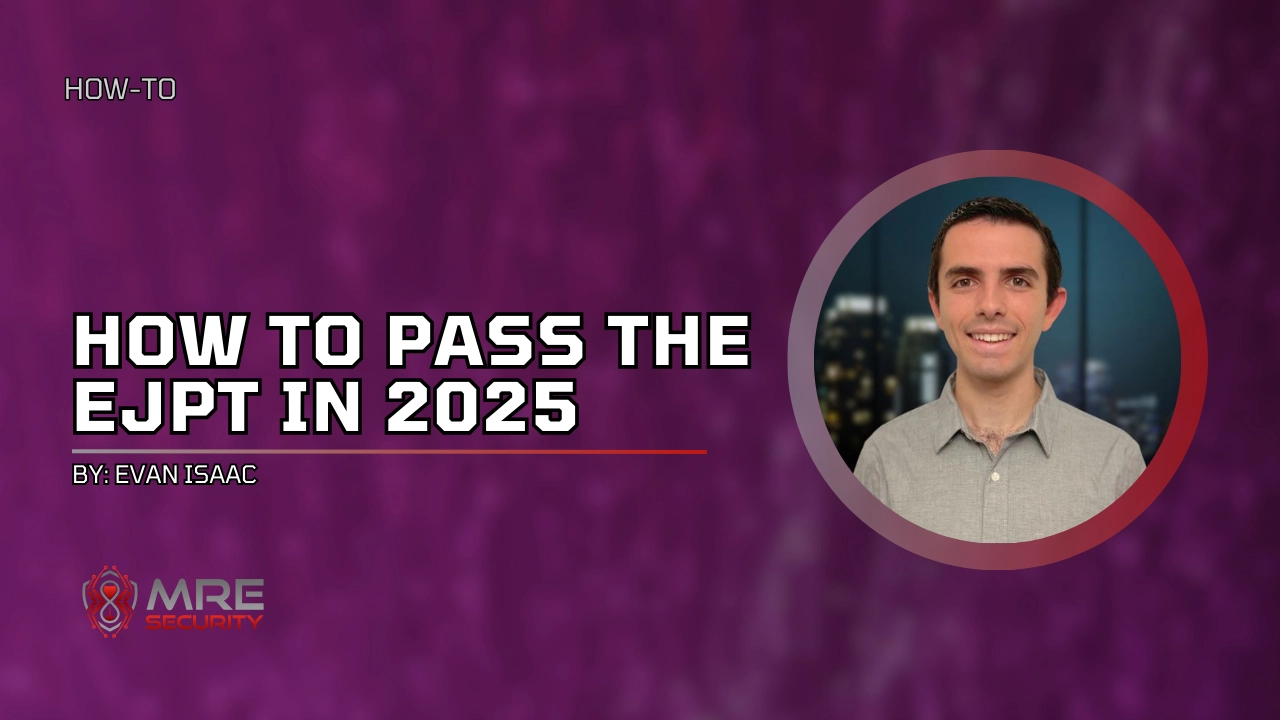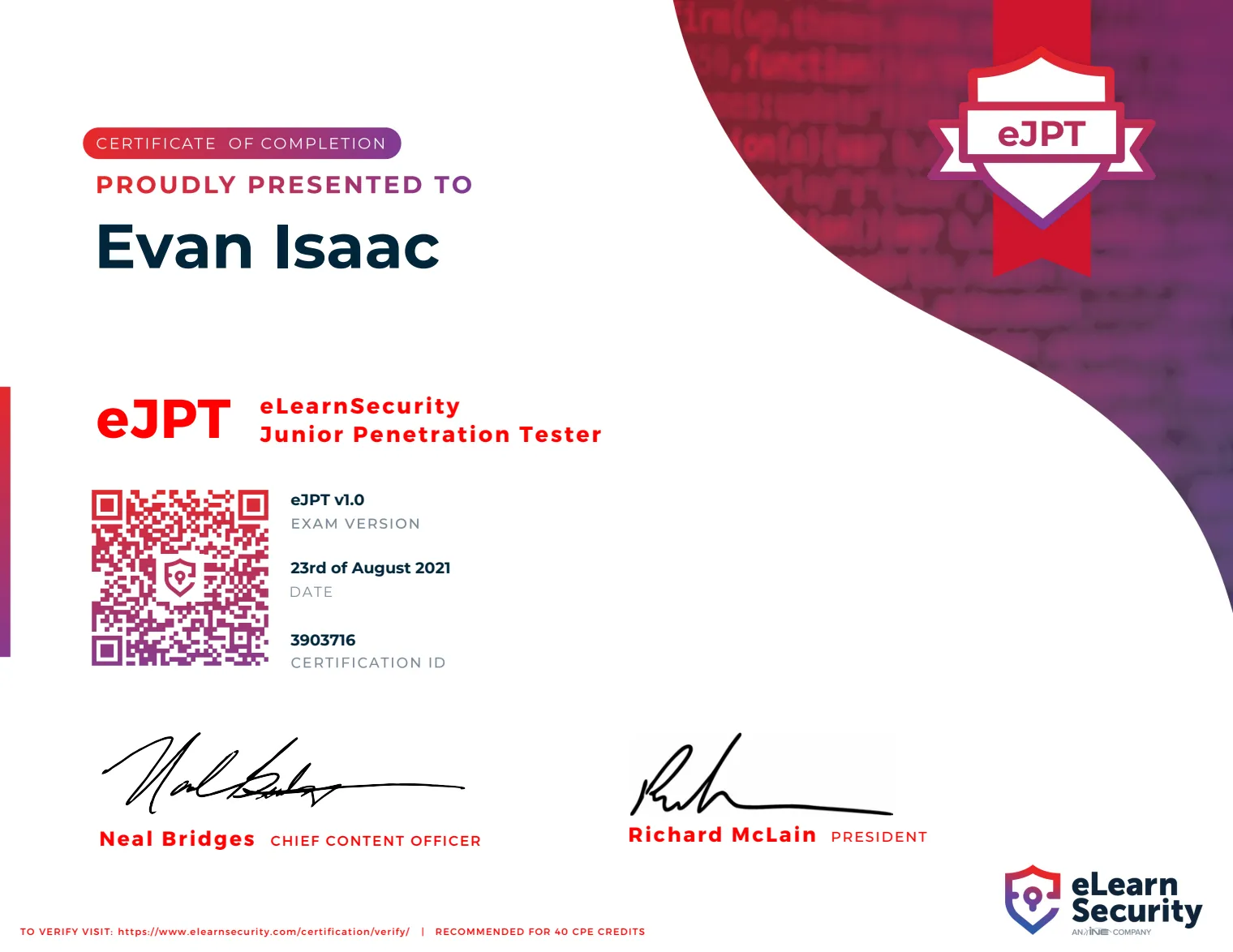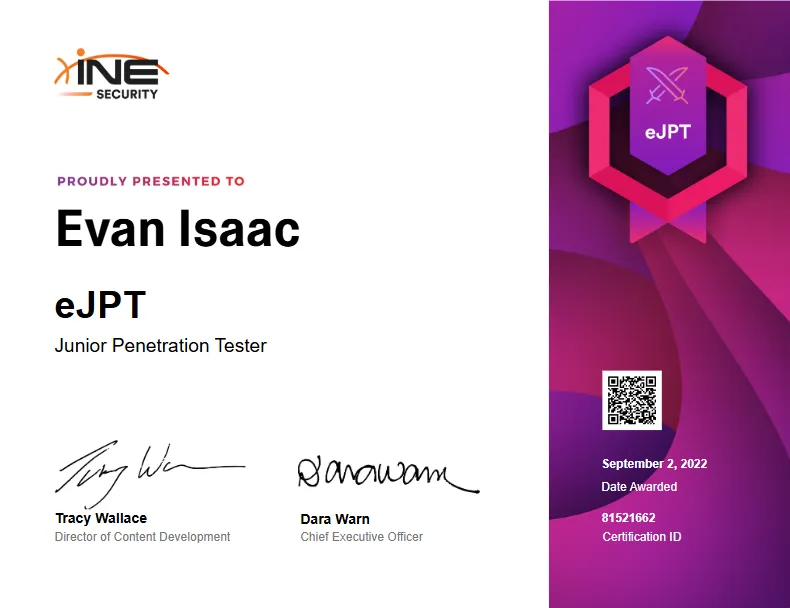How to Pass the eLearnSecurity Junior Penetration Tester (eJPT) Exam (Step-by-Step Guide)
3 min read

Introduction
If you’re starting in cybersecurity and looking for your first practical certification, the eLearnSecurity Junior Penetration Tester (eJPT) is a great place to begin. This guide breaks down exactly how to study, what to practice, and how to confidently pass the exam.


What is the eJPT?
The eJPT is an entry-level penetration testing certification that focuses on various topics related to penetration testing. This is a hands-on practical exam that requires a fundamental understanding of the penetration testing methodology.
You’ll learn various skills such as network and web penetration testing, host enumeration, OSINT, active/passive reconnaissance, and more.
The exam consists of 35 questions and is 48 hours long. The course comprises 153 hours and 38 minutes of content with over 240 videos, 200 quizzes, and 108 labs.
You can find the course structure here.
Please note, the new eJPTv2 exam does expire after 3 years.
Why I Recommend the eJPT
When I started my cybersecurity journey, I always wanted to be a penetration tester. A buddy of mine recommended eLearnSecurity as a good platform to start. At the time, eLearnSecurity merged into INE Security, and the pricing model changed quite a bit. However, during Halloween, INE Security hosts a BooGo sale, during which I got two years of unlimited platform usage and two certification vouchers.
I ended up buying the eJPT separately for a discounted rate of 50% off because of another sale they were having. However, the eJPT showed me the penetration methodology. After completing the course, I fundamentally understood OSINT, active/passive recon, network security, and web application security. They teach you about Metasploit and how to enumerate a target to find vulnerabilities on different ports.
I completed the exam and ended up taking the eJPTv2 as a beta tester. The eJPTv2 was different than the eJPTv1 as you needed to use the built-in VM within the browser, which I’m not a huge fan of. Nonetheless, after passing that, I gained confidence to begin a more professional certification, the eLearnSecurity Certified Professional Penetration Tester (eCPPT) exam.
Without the eJPT, I’m not sure I would be where I am today. It should be all the fundamentals that I needed to begin my journey, and over time, I learned different skills and expanded my knowledge within the penetration testing realm.
Tips for the Exam
- Learn pivoting—Understanding this component of the course material is difficult. However, it is a must to pass the exam. Make sure to spend a bunch of time on it, and maybe make a home lab that includes pivoting.
- Take in-depth notes during your study — they’ll help during the test. Make sure to write down all commands you see, what they do, how they work, and when to use them. Stay organized with your notes. In a separate folder, make categories so you don’t have a long list of notes floating around.
- Read every question carefully. Some questions may be confusing, and you’ll get stuck. Try to understand what the questions are asking. The questions guide you through the process, not trick you. If you get stuck, try a different question, but when I took the exam, most of the questions flowed into the next.
- Don’t rush — use the full 48 hours if needed. It’s a beginner certification; they want you to take all the time you need to succeed. Be patient, because everything you see on the exam was taught in the course. Don’t forget, they’re not trying to trick you and make you go down a rabbit hole. They want you to learn the fundamentals in a practical exam.
Resources to Pass the eJPT
While the course and labs within the course are sufficient for passing the eJPT, if you want additional resources, here are some Github repositories and TryHackMe rooms to check out:
- Dev-angelist eJPTv2 Notes
- Ernesto Cubo eJPTv2 Notes
- Nmmorette’s eJPTv2 Cheatsheet
- Methodological Notes eJPTv2 Preparation
- Basic Pentesting (TryHackMe)
- Bounty Hacker (TryHackMe)
- RootMe (TryHackMe)
- Simple CTF (TryHackMe)
- Lazy Admin (TryHackMe)
- Pickle Rick (TryHackMe)
- Startup (TryHackMe)
- Mr Robot CTF (TryHackMe)
Final Thoughts
The eJPT is more than a certification — it’s a confidence builder. Whether you’re aiming for a career in ethical hacking or want to understand better how networks are attacked and defended, passing this exam will open doors. It certainly did for me. After the eJPT, you can begin preparing for the eCPPT, which is the professional version of the eJPT. You will learn bypass and more advanced techniques. The eCPPT is what landed me my dream job as a penetration tester. A blog will be out soon, so stay tuned!
Authors

Lead Technical Writer
Evan is a dedicated cybersecurity professional with a degree from Roger Williams University. He is certified in GRTP, OSCP, eWPTX, eCPPT, and eJPT. He specializes in web application and API security. In his free time, he identifies vulnerabilities in FOSS applications and mentors aspiring cybersecurity professionals.
Recent Posts

HuntressCTF 2025 Malware Challenges – Writeups & Analysis
Learning about malware analysis through HuntressCTF challenges. Deobfuscate code and using Telegram API to retrieve the flag.
Nov 1, 2025

HuntressCTF 2025 Miscellaneous Challenges - Full Writeups
Explore the unexpected in HuntressCTF 2025 Misc challenges. Creative puzzles, crypto quirks, and logic traps that test your problem-solving edge.
Nov 1, 2025

HuntressCTF 2025 OSINT Challenges – Full Writeups
Learn about identifying a threat actor and using Google Reverse Image search to identify their exact location.
Nov 1, 2025
